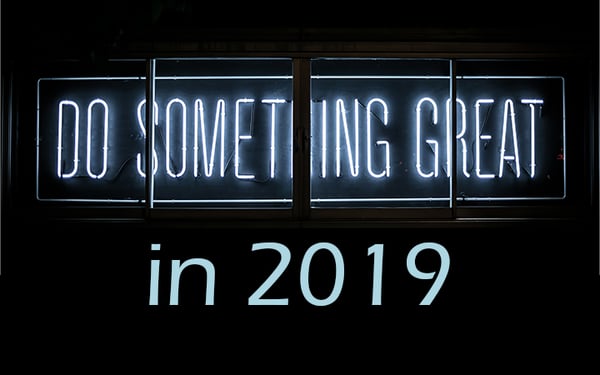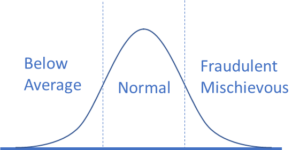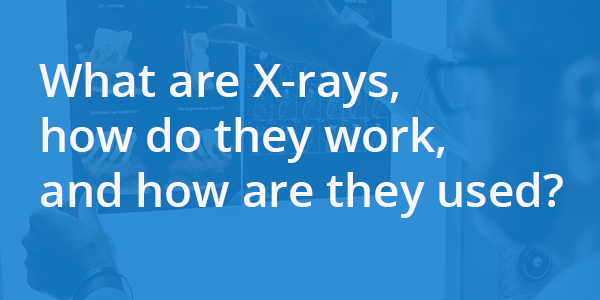
7 Ways to succeed in 2019
Over the last 20 years I have read time and again the analysts’ reports of which technology is going to be the big new thing for the year ahead. Whilst many of these trends have come and gone or crossed their chasm (or fallen to their peril), there are still many of the underlying issues facing companies today if they want to compete.
A more cynical person might be forgiven for arguing that despite all the recent technology innovations and the millions spent on big IT projects we are still in the same predicament.
So, what is to be done? Where should you focus your efforts to maximise your returns from this years’ efforts?
1. A.I. is meaningless, long live I.A.
There is nothing like kicking off with controversy, but is there a single thing out there that doesn’t claim to have Artificial Intelligence and or Machine Learning? I am even expecting it to show up on food labelling soon. I am sure someone can write me an algorithm to prove if all marketing departments claim their IT products have AI or not (Don’t worry I know the contradiction in what I wrote there – that isn’t AI – I get it). In their very readable but perhaps not catchily titled tome “Machine, Platform, Crowd: Harnessing Our Digital Future”, Andrew McAfee and Erik Brynjolfsson argue that “companies need to rethink the balance between minds and machines, between products and platforms, and between the core and the crowd.” I think this book is part of your essential background reading for modern IT professionals or corporate strategists. Whilst I was genuinely surprised by the improvement in AI and had missed the significance of a computer beating a human at the board game GO it still resonated to me that the human is far from obsolete.
So yes, we can Digitally Transform our businesses, perform Channel shift and embrace the globally connected crowd. But look across your business and tell me is everything as automated as it could be? Take a classic view across your back office and front office and ask could this be better? For almost every organisation the answer is a resounding yes. This is despite huge expenditure on IT and consultants - and AI isn’t going to move the needle in and of itself is it?
Indeed, even the brightest minds have proudly unleashed AI on the world, only to find that the world is a little older and wiser and has a few spanners to throw at it. Do you remember the Microsoft chatbot Tay, that learnt from the messages it interacted with only for it to be ‘taught’ to appear to be a racist bigot? Or The reported incident of a Facebook algorithm (OK not pure AI) removing a section of the US Declaration of Independence for contravening the rules on hate speech.
“For me the focus should not be on Artificial Intelligence, AI, but rather on IA or Intelligent Automation”.
Intelligent Automation uses all the smarts from Machine Learning and true AI and adds this on top of business process automation to take a huge chunk of effort out of what you need to do every day.
Douglas Adams wrote many years ago about intelligent machines that would watch TV for us to save us huge amounts of time and electronic monks that would believe in things for us, so we didn’t have to. In business is it easy to see automation as the realm of robots building cars and forget that much of what we type into a keyboard is brainless automaton work (Just take this article as proof!) and all we are doing is moving muscles in our fingers but the brain isn’t really needed or engaged. Need to place an order from a customer, update an accounting record, enrol an employee, key like a slave into the core system. Also, seemingly every IT vendor out there is focused on Intra efficiency within their own application, but companies as a whole are made up of hundreds of IT applications across potentially hundreds of departments in hundreds of countries.
What we need are intelligent process orchestration engines that embrace complex back end systems and complex business processes and allow the business to automate these tasks in a standard compliant way. Now if these orchestration engines have robotic process automation baked in and can eliminate the need for humans to brainlessly key into computers then we are on to a winner. If on top of that they can also have decades of AI and Machine learning code in them that allows them to understand the context and meaning of the documents and data, they are processing then we could be cooking on gas (sorry induction). Of course, I want all this from a proven Enterprise IT provider who have been doing this for years and have tens of thousands of happy customers. To date I have only seen 2 companies come close to this Nirvana, Pega the King of BPM and Kofax the King of Intelligent Automation. I am sure others exist, let me know in the comments section.
2. One Direction
Now I am not suggesting we all listen to the 2010 boy band, although in many ways it is the “little things” that make the difference. So, what am I talking about? OK, here is an experiment. Think of an IT company. A global, mega entity. Got one? Good. Now tell me the name of their CEO or the person that built it. In most cases you will be able to name a single person. In most cases is it because everyone rallies around a single figure a Jobs, Ellison, Musk, Welch, Bezos (I do wish this was the operating system of the Kindle) etc. Now these people are not always right and they certainly credit the teams around them but things get done because people follow a single direction.
They say that a Camel is a horse designed by a committee and it is true. I heard about a renowned business guru who would have his whole crowd of attendees stand up and with their eyes closed he would ask them to point North. They then open them and laugh as the room is full of people pointing in different directions. I won’t spoil the whole story for you but basically if you have lots of people all pulling in different directions it makes it very hard to get there. If any of you reading this have a family and you consult on what you are going to do at the weekend or for a holiday, often it is much harder than if one of you decided and the others went along with it.
So how is a business supposed to offer IT systems and applications when there are hundreds of requirements often competing. Many of my customers tell me that their organisations has hundreds of applications to support and every day it seems like they find another department who have signed up to a new cloud based subscription service that just solves one specific issue, but could the IT department integrate it into other back end systems please, Ahhh.
So, the most important thing perhaps that you can do is agree on a single strategy and do that first. Then the next thing and then the next. Sure, some of them might fail and some of them might be better if more people had been involved in the decision. But the world is littered with failed IT projects that took months or years to procure and involved seemingly endless stakeholders. If everyone was being honest though, they never really defined exactly what was needed and then continually changed their collective minds.
3. I wouldn't start from here!
Have you heard the old story of someone being lost and asking a local how to get to somewhere only to hear those immortal words, “I wouldn’t start from here!”? Often it is easier for an enterprise to admit that trying to turn around the proverbial ocean liner is both a crazy risk and impractical.
I like the many stories of organisations that let their teams start again. Build a brand-new business or organisation without any of the shackles of the past. No baggage, only experience and deep pockets backing them. It is a powerful way to reinvent yourself and perhaps it is better to engage your own teams to do this rather than wait for them to get frustrated and leave and do it anyway on their own in competition against you.
If you allow your organisation to be free to adapt to new realities and paradigms, then you are likely to be riding the next wave rather than drowned by it.
4. Trust no one
They say that a burglar looks at a property and thinks first about how they will get out before how they will get in. Whilst I have no idea of whether this is true or not, it highlights the issue that we don’t all think in the same way. We might assume compliance and controls and think things are secured but there will always be someone who thinks differently.
A wise person shared with me the bell distribution curve of effectiveness, now this isn’t my model so please don’t shoot me for the wording but of course the vast majority of us are normal (that’s the point right!). At one end we have those people that are below average, and we work tirelessly to help them become more effective. But the useful thing in this model is that at there are 2 other ends. At the other end there are people that are deliberately trying to work against the system. These process Saboteurs might have mischievous or malicious intent, but they are thinking about your systems and processes in a very different way than you are. Ironically these are just the people you need to test your systems. Think hackers becoming security consultants and virus authors creating anti malware programs.
Do you want these people working with you or against you?

5. Human Resources to be responsible for robotic workers
Many studies have now been produced that estimate that many of the tasks that we do in the office are due to be replaced by a new wave of digital workers.
Below is my model that shows up to 60% of all tasks could soon be replaced by robots (either physical or software (known as Robotic Process Automation (RPA) Bots))). Clearly, each role we perform for our organisation will vary in the percentages of effort required. Many of us realise that physical robots have taken over many jobs, especially in manufacturing. Now, initially we were scared that the human would be replaced, but the reality is that more jobs have been created and now the dangerous and boring repetitive work can be delegated to bots.
Those of you who follow my regular posts will know my excitement about Robotic Process Automation that extends the benefits from hard physical work over to anything typically done via a keyboard. Now, software bots can key orders, invoices, move data between systems and perform many of the tasks we used to ask people to perform. Of course, if your chosen RPA tool has AI and Machine Learning in it and you can ask it to orchestrate any process across any system, then you unleash the real power of this technology. In my model below, I work with HR departments to scope out job roles into three areas. Zone 3 where we are just asking the human to act like a drone and key mindlessly into or between applications and systems. This is a perfect candidate for RPA 1.0
Zone 2 is more cerebral and uses the frontal cortex of the brain but at its heart, many of the ‘decisions’ we are making can be learnt or codified. Some people are even thinking this is within the realm of healthcare and that systems can be better at prognosis that humans. But certainly, I see on a daily basis, tools that read incoming emails and documents then perform actions and routines based on their understanding of the contents of the communication. In the past we needed humans to read and understand what was being asked before actioning.

So now up to 60% of your organisation’s tasks can be intelligently automated. So, is there a place for the human? Of course. There will ‘always’ be creative, intuitive or emotional decisions that need to be made – in Zone 1. HR can work with departments and IT to codify these roles and map out the perfect environment where drone work is given to the drones and rewarding creative work is shared with the humans. We all deserve to have Zone 1 work.
One final thought here, I am not suggesting for one minute that humans won’t perform manual work. Hand crafted cars can be the best in the world or a health and safety nightmare. If humans are needed to be involved or enjoy being involved allow it. But replace inefficiency, non-value adding, dangerous and soul-destroying work.
6. No more animals in the zoo
My favourite quote from a customer last year was from an embattled IT Director who being presented with daily requests for new software applications said emphatically “I don’t want any more Animals in the Zoo!”. One of my other customers is responsible for many hundreds of applications and when we looked at them in more detail over 80% of them were just specialised forms of case management.
I always thought that the ERP was the one and only system that an organisation needed. If this isn’t the case, then I suggest we need in 2019 to look very closely at Rapid Application Development tools that will allow us to retire hundreds of applications onto a single flexible and totally agile tool. If you haven’t seen such tools, they are getting better every year. Imagine a system, then imagine it built and in production in a couple of weeks. All with no code and with little or no one from IT needed only the process owners.
I hate the devastation we see when natural fires rip through woodland or grasslands, but nature knows how to level things. Think across your estate of programs and applications about all the deadwood that is strangling your business and taking resources. Perhaps 2019 is the time to prune back to basics before things catch fire.
7. Mission Impossible - Living the dream
OK, we now reach our final and most important objective for 2019. Most businesses’ mission is to maximise the return for the shareholders. This whilst seemingly critical to a market economy misses out on why we all turn up to work. I have argued elsewhere that maximising customer and employee value often leads to increased shareholder value but focusing on the shareholder alone may not help staff or customers at all.
I am reminded of the scene from the Blues Brothers where they go glassy eyed and explain their actions with the now famous and many T Shirt covering phase “We are on a Mission from God”.
How do your employees see their jobs? What value do your customers think you offer to humanity? We have all seen hugely successful businesses that are chock full of talent passionately engaged in the business. My mission, should you wish to accept it, is to have all your team say without irony, they are “living the dream”
If you have any questions about how we can help your business in 2019, please complete the form below.
Tim Miller
Digital Transformation Expert

.png?width=828&height=208&name=Twofold-Logos-no%20drop%20(1).png)


